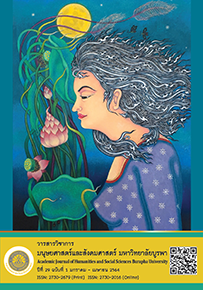A Factor and Cluster Analysis of Chon Buri Destination Image for Market Targeting with Tourists’ Revisit Intention
Main Article Content
Abstract
The objectives of this study were to investigate tourist’s perceptions of destination image of Chon Buri, to classify tourist groups based on the destination image factors as well as determine revisit intention through clustered tourist groups. Survey research was conducted. A high-quality questionnaire was used to collect the data from 400 tourist samples. Descriptive statistics were calculated and Inferential statistics with factor-cluster analysis was performed with .05 level of statistical significance.
The findings revealed that tourists rated destination image as quality of experience the most. Using factor analysis, there were such five destination image factors as society and culture, naturalness, privacy and dislike to join activities, naturalness and preference to join activities, and preference of climate. According to cluster analysis, it was found that there were such four tourist clusters: 1) tourists who were interested in society and nature; 2) tourists who were interested in nature but dislike to join activities; 3) tourists who were interested in society and culture and like to join activities; and 4) those who were interested in nature and climate. Accordingly, tourists of cluster3 had the highest chance to revisit intention.
Downloads
Article Details
บทความทุกบทความเป็นลิขสิทธิ์ของวารสารวิชาการมนุษยศาสตร์และสังคมศาสตร์ มหาวิทยาลัยบูรพาเท่านั้น
References
กัลยา วานิชย์บัญชา. (2562). การวิเคราะห์สถิติขั้นสูงด้วย SPSS for windows (พิมพ์ครั้งที่ 14). กรุงเทพ: สำนักพิมพ์จุฬาลงกรณ์มหาวิทยาลัย.
ธิติพร ชาญศิริวัฒน์. (2561). ความต้องการสารสนเทศการท่องเที่ยวเชิงสุขภาพในประเทศไทยของนักท่องเที่ยวไทย. วารสารสารสนเทศศาสตร์, 36(4), 2-17.
รังสิมา อุ่นโสภา. (2561). ปัจจัยภาพลักษณ์ การคมนาคมและการประชาสัมพันธ์ที่ส่งผลต่อการตัดสินใจของนักท่องเที่ยวในการท่องเที่ยวที่ตำบลอัมพวา จังหวัดสมุทรสงคราม. วิทยานิพนธ์บริหารธุรกิจมหาบัณฑิต, สาขาวิชาบริหารธุรกิจ, คณะบริหารธุรกิจ, มหาวิทยาลัยกรุงเทพ.
ศิริกันยา อารัญ. (2551). ภาพลักษณ์ในมุมมองของนักท่องเที่ยวจังหวัดกรุงเทพมหานครที่มีต่อจังหวัดเชียงใหม่. วิทยานิพนธ์การจัดการมหาบัณฑิต, สาขาวิชาการจัดการวิสาหกิจขนาดกลางและขนาดย่อม, คณะมนุษยศาสตร์และสังคมศาสตร์, มหาวิทยาลัยบูรพา.
สำนักงานสถิติแห่งชาติ (2563). สรุปสถานการณ์ท่องเที่ยวภายในประเทศ เป็นรายจังหวัด พ.ศ. 2553-2562. เข้าถึงได้จาก http://statbbi.nso.go.th/staticreport/page/sector/th/17.aspx
อนุรักษ์ ทองขาว, โสพิชา เถกิงเกียรติ, ภัทรานิษฐ์ งามวงศ์น้อย และพูลพงศ์ สุขสว่าง (2562). อิทธิพลของภาพลักษณ์การท่องเที่ยวที่มีต่อความภักดีของนักท่องเที่ยวที่มาบาลีฮาย พัทยา เพื่อก้าวเข้าสู่เขตพัฒนาพิเศษภาคตะวันออก. วารสารวิทยาลัยดุสิตธานี, 13(2), 67-82.
Baloglu, S. (1997). The relationship between destination images and sociodemographic and trip characteristics of international travellers. Journal of Vacation Marketing, 3(3), 221-233.
Baloglu, S., & Mangaloglu, M. (2001). Tourism destination images of Turkey, Egypt, Greece, and Italy as perceived by US-based tour operators and travel agents. Tourism Management, 22, 1-9.
Baloglu, S., & McCleary, K. W. (1999a). A model of destination image. Annals of Tourism Research, 26(4), 868-897.
Baloglu, S., & McCleary, K. W. (1999b). US international pleasure travelers’ images of four Mediterranean destination: A comparison of visitors and non-visitors. Journal of Travel Research, 38(2), 144-152.
Cha, S., McCleary, K., & Uysal. M. (1995). Travel motivations of Japanese overseas travelers: A factor-cluster segmentation approach. Journal of Travel Research, 34, 33-39.
Echtner C. M., & Ritchie, J. R. B. (1993). The measurement of destination image: An empirical assessment. Journal of Travel Research, 31(4), 3-13.
Edlinger, P. (2015). An analysis of the impact of photographing on the visitors’ emotional experience at cultural spaces and their postvisit behavioural intentions. A Master of Science Thesis, Faculty of Tourism, University of Ginrona.
Fakeye, P. C., & Crompton, J. L. (1991). Image differences between prospective, first-time, and repeat visitors to the Lower Rio Grande Valley. Journal of Travel Research, 30(2), 10-16.
Kotler, P., Haider, D. H., & Rein, I. (1993). Marketing places: Attracting investment, industry, and tourism to cities, states, and nations. New York: Free Press.
Mazanec, J. A. (1997). Segmenting city tourists into vacation style. In K. Grabler, & J. A. Mazanec (Ed.), International city tourism-analysis and strategy (pp. 114-128). London: Continuum Intel Pub Group.
Morgan, N., Pritchard, A., & Pride, R. (2012). Destination branding (3rd ed.). Oxfordshire: Routledge.
Nunnally, J. C. (1978). Psychometric theory 1998. New York: McGraw-Hill.
Pagano, N. (2014). Tourism destination image and Irish websites. International Journal of Business and Social Science, 5(8), 178-188.
Polit, D. F., & Hungler, B. P. (1999). Nursing research: Principles and methods. Philadelphia: JB Lippincott Company.
Slivar, I., Aleric, D., & Dolenec, S. (2019). Leisure travel behavior of generation Y & Z at the destination and post-purchase. E-Journal of Tourism, 6(2), 147-159.
Walmsley, D. J., & Jenkins J. M. (1993). Appraisive images of tourist areas: Application of personal constructs. Australian Geographer, 24(2), 1-13.
Yamane, T. (1967). Elementary sampling theory. Englewood Cliffs, New Jersey: Prentice-Hall.
Yang, Y. W. (2017). National destination image and outbound travel intention. Business Management Journal, 17(4), 143-158.


